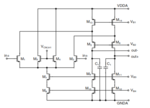Junus2012
Advanced Member level 5
Hello All
attached is a fully differential folded cascode amplifier with simple CMFB circuit on the input differential stage, the princible of this circuit is very easy and doesnt require sepearte amplifier or averaging scheme, however, I only see this type with booster ampliifer that used to increase the gain of the main ampliifer, I never seen it to be emplyed with the main ampliifer,
Could you please explain me why ?

Thank you in advance
attached is a fully differential folded cascode amplifier with simple CMFB circuit on the input differential stage, the princible of this circuit is very easy and doesnt require sepearte amplifier or averaging scheme, however, I only see this type with booster ampliifer that used to increase the gain of the main ampliifer, I never seen it to be emplyed with the main ampliifer,
Could you please explain me why ?

Thank you in advance